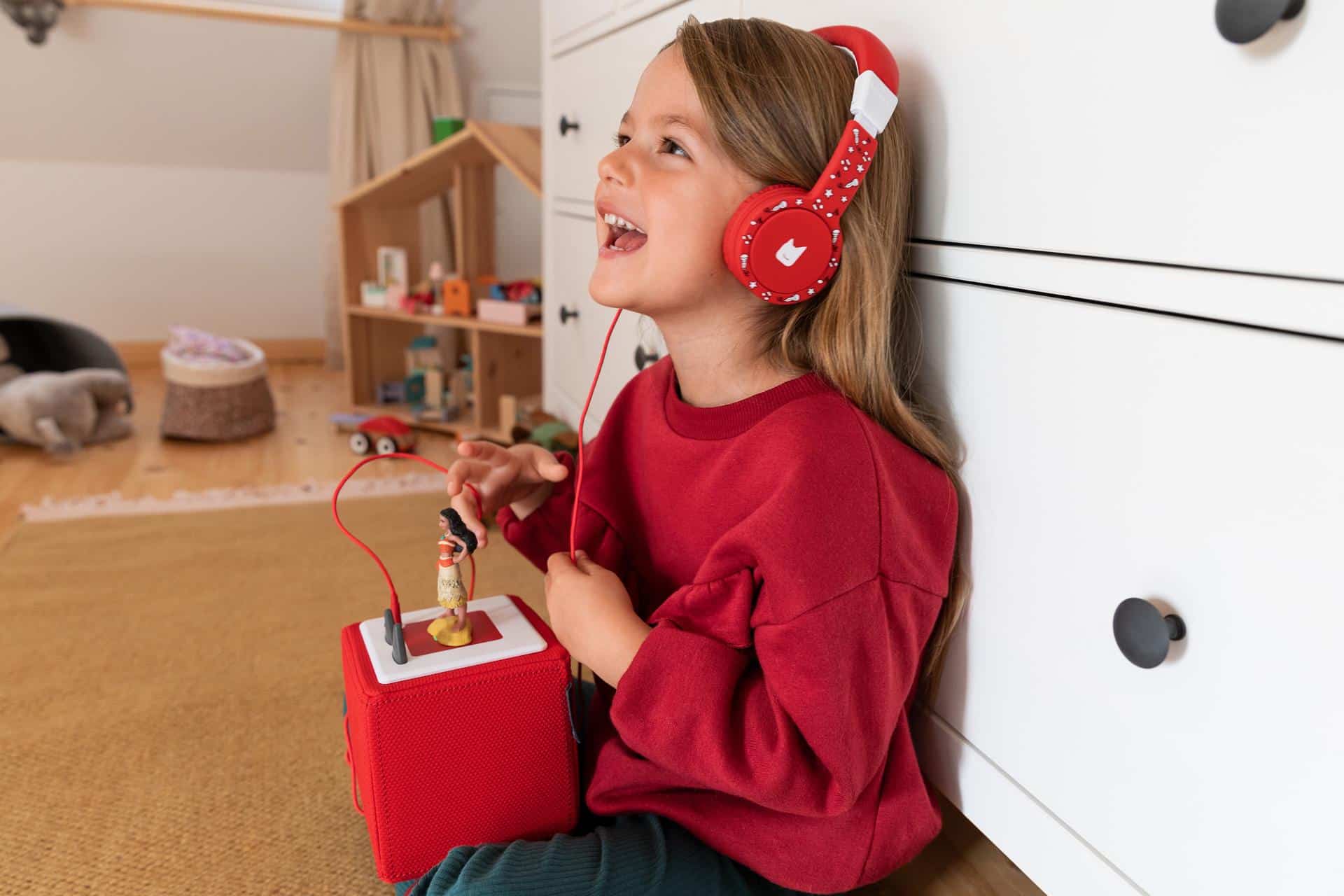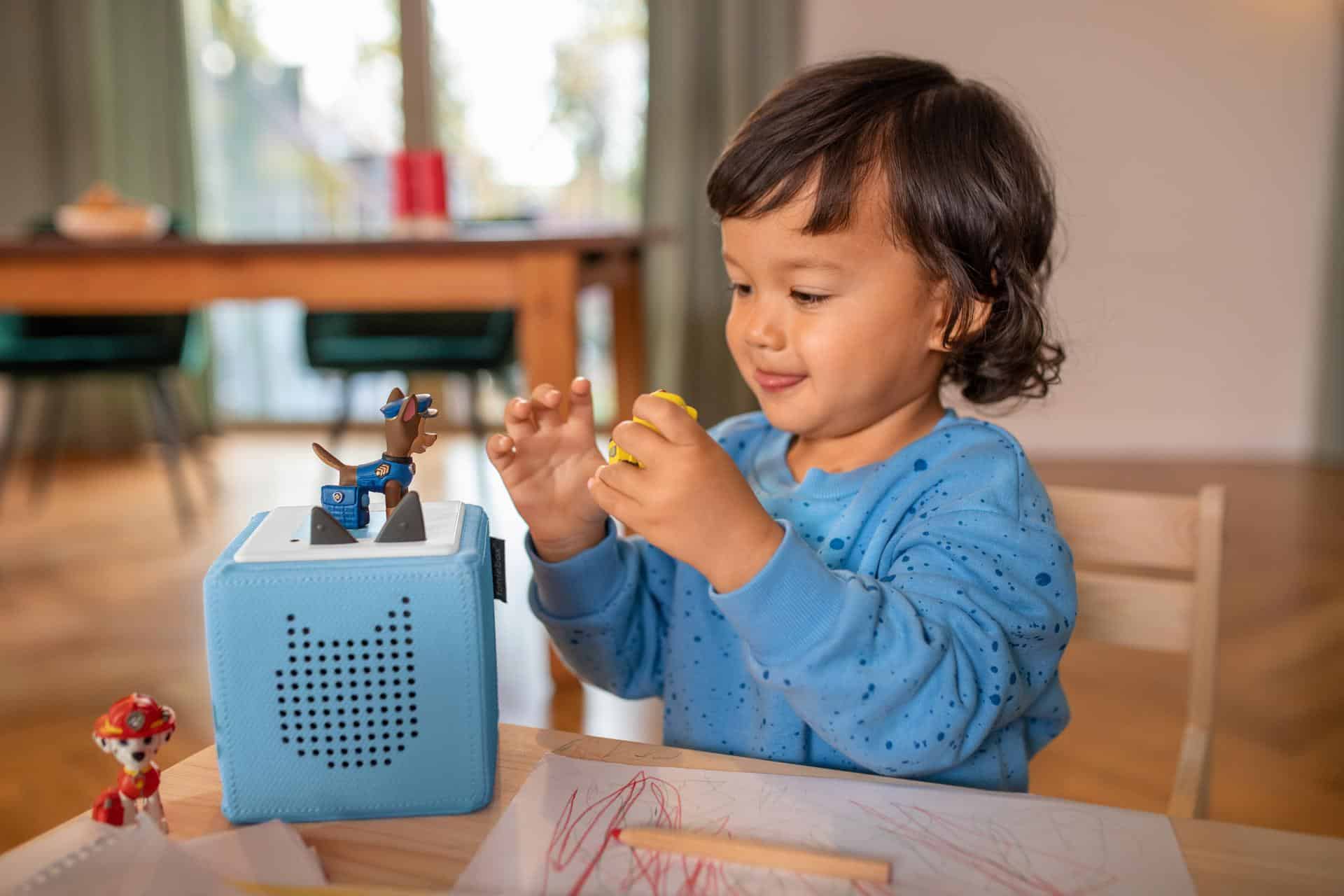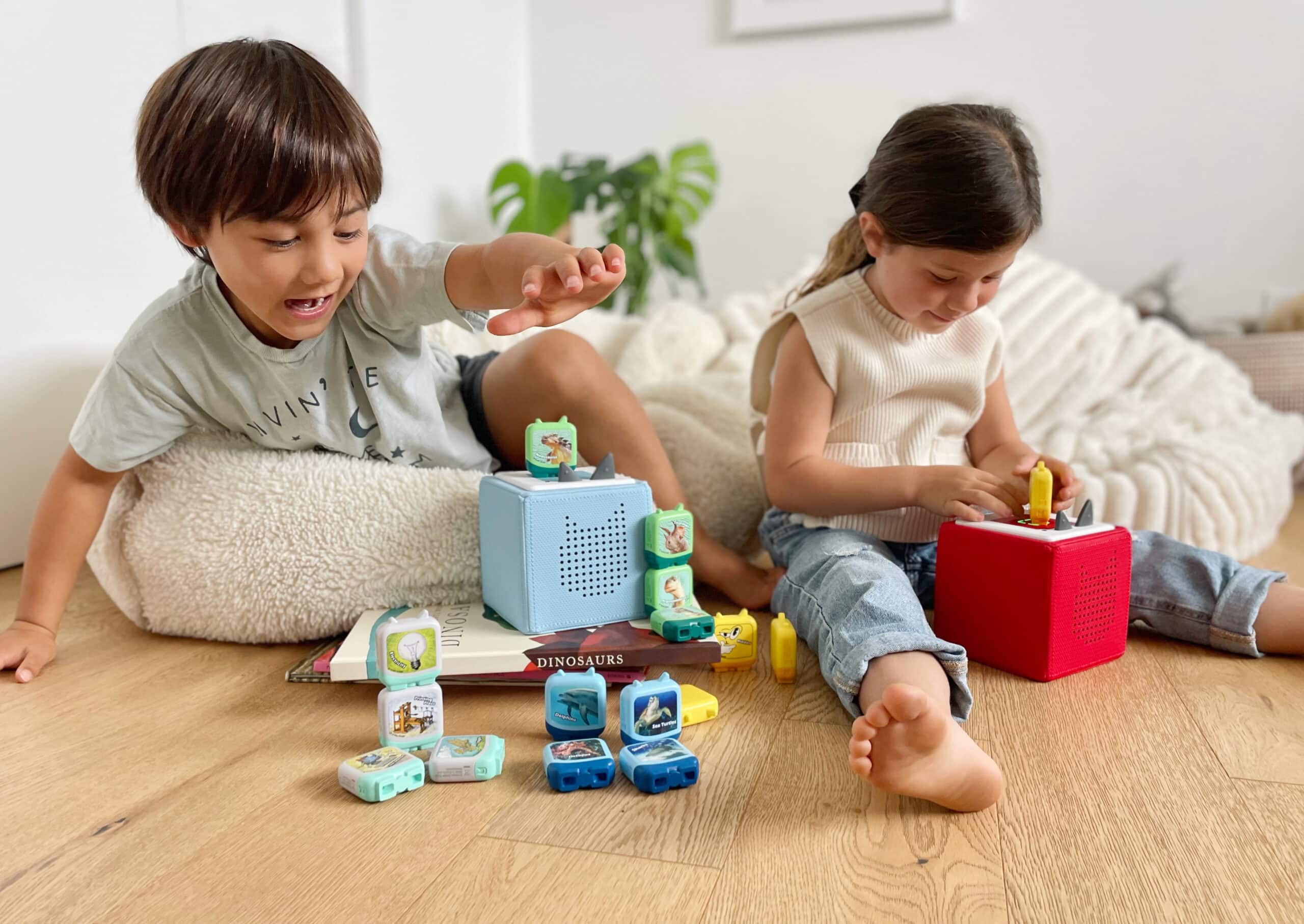What age is the Toniebox suitable for?

Photo copyright: Disney and tonies®
Official age recommendation from Tonies®
The manufacturer recommends the Toniebox for children aged three and over. This recommendation is not chosen at random, but is based on various criteria:
Firstly, a child must be able to place the figures safely and purposefully on the box. The Tonie figures contain magnets that stick to the box, and attaching and removing them requires a certain amount of fine motor skills. Children should therefore have enough dexterity to grasp a figure and place it correctly on the cube without it slipping off the box or falling off. Secondly, safety standards play a role: toys intended for children under the age of three must comply with stricter regulations, for example with regard to small parts and choking hazards. Tonies meet these standards from the age of three. Thirdly, a child should have understood that tapping and tilting the box controls playback. For example, tap once lightly to pause, or tap twice to skip forwards or backwards. These operating concepts require a certain degree of cognitive maturity. After all, the child must understand that the volume can be limited in the app and that they can turn it down on their own.
Tonies itself emphasizes in the FAQs that three years is not a strict limit, but a recommendation. Parents are told that children under three can certainly play with the box, but only under supervision and with figures specially developed for the youngest children. The reference to the volume refers to the fact that very loud music can be a strain for sensitive children's ears. The app therefore makes it possible to permanently limit the maximum volume to a safe level.

Photo: tonies®
Is the Toniebox a sensible gift for a 1st birthday?
In practice, we often see families using the Toniebox before the child's third birthday. There are various reasons for this. Some parents have had positive childhood experiences with audio books themselves and want to introduce their child to audio games as early as possible. On the other hand, special baby Tonies and Schlummerbande figures are very easy to use without the child having to control the box independently. Parents take control and put on a Tonie before bedtime, for example, while the child is still playing or falling asleep.
Practical tips for use with 1 or 2 year old children:
- Set up the Toniebox so that toddlers cannot reach it unsupervised.
- Use mainly music Tonies or snooze Tonies so that the volume and content can be better controlled.
- Parents start playback and take the box away again after a certain time.
- Limit the maximum volume via the app.
Even one to two-year-old children can benefit from simple songs. Familiar rhymes or short children's melodies such as "Bruder Jakob" or "Backe, backe Kuchen" can be understood and hummed along to even without complex stories. Parents encourage their little ones to sing along, which provides the first linguistic stimuli.
Development checklist
Whether your child is mature enough to handle the Toniebox independently can be assessed using a few criteria. The following list shows typical developmental characteristics that are relevant:
- Purposeful action: Your child can purposefully pick up and put down an object, for example a pen or a small bowl.
- Understanding simple commands: The child understands "put the figure on, then the music starts" or "put the figure down when you're finished".
- Perseverance and patience: They stay with a story or music for several minutes without becoming impatient.
- Reaction to interruptions: When playback stops, the child remains calm and knows to tap or tilt again to continue.
If several of these points apply, your child is usually able to deal with the Toniebox independently (even if not yet perfectly). If they are not yet ready, an adult can operate the box or use it as a shared medium until their fine motor skills and understanding grow.
Tonies for the little ones (under three years)
Although the official recommendation is for ages three and up, Tonies offers special figures for babies and toddlers. The so-called snooze gang Tonies in particular are designed to soothe even the very youngest children. The best-known models in this range are the Slumbering Whale, the Slumbering Bunny and the Slumbering Penguin.
Snooze gang in detail
- Slumbering whale
The figure combines 120 minutes of the gentle sound of the sea with soothing lullabies. The gentle sound imitates the sound of the ocean, which calms many babies. At the same time, the soundtrack alternates between noise and calm sleep music to bring variety to the bedtime ritual. - Slumber bunny
Filled with heartbeat sounds that can remind you of your own mother, the bunny also provides classic lullabies. The regular heartbeat creates a sense of security, while the music is perfectly attuned to falling asleep. - Slumbering penguin
This Tonie plays icy wind noises in combination with soft melodies. Many babies find the gentle whistling of the wind pleasant because it balances out background noises and they are not so surprised by sudden everyday noises.
A common feature of all Schlummerbande figures is the integrated night light, which glows a soft orange and switches off automatically when playback is finished. This creates a peaceful sleeping environment without bright lights that could disturb children.
Noise tonics for babies
In addition to the sleep figures, white or brown noise can also be used to mask ambient noise. Parents report that such monotonous noise helps, especially in noisy living environments, because the children are less likely to be woken up by neighborhood noise or traffic announcements. However, it is important that no continuous loop runs throughout the night. The rule of thumb is a maximum of 40 minutes per playback mode so that the hearing is not overloaded.
Classics in baby version
Some Tonies offer slimmed-down stories from well-known series, such as "Die kleine Raupe Nimmersatt - Schlaf schön" or a five-minute abridged version of "Peter and the Wolf". These shortened stories focus on melodies, rhymes and catchy lyrics. This is ideal for young children because the full story is often too complex and they quickly lose interest.
Parents like to use these mini versions to teach children their first stories without overwhelming them. At the same time, the certain repetition offers a learning effect: children recognize familiar melodies and experience a kind of recognition value that gives them security.
Age-appropriate Tonie selection from the age of three
The Toniebox enters its target group at the age of three. Now children can independently choose their favorite stories and operate the functionality of the box on their own. The range of content increases with age, and it is worth knowing suitable categories:
Three to four years
At this age, first favorite characters often appear:
- The Little Raven Sock: Humorous everyday stories, often with animal friends, encourage excitement and first moments of laughter.
- Bobo Siebenschläfer: Short episodes from the life of a little dormouse, ideal for the attention span of three-year-olds.
- Leo Lausemaus: Stories that revolve around typical children's problems, such as brushing their teeth or staying alone, accompany little ones in their everyday lives.
These characters are characterized by the fact that they are told very simply, contain many repetitions and offer plot concepts that are easy to follow.
Five years
From around the age of five, knowledge toys become more important:
- What's What - Dinosaurs: Short facts about different types of dinosaurs combined with child-friendly language and exciting sound effects.
- What's What - Space: Introductory topics about planets, stars and the universe, told in an easy-to-understand way.
- Knowledge for children - Our body: First insights into anatomy, told with little stories and questions that arouse curiosity.
These Tonies not only encourage the urge to learn, but also expand vocabulary and understanding of scientific topics. They motivate children to ask questions and deepen their interest in certain areas.
Six years and older
Clever-Tonies come into play at the age of six. These special figures can be individually filled with content:
- Language learning: parents upload simple English lessons that teach numbers, colors, greetings and first vocabulary.
- Math basics: Short explanations and exercises on understanding numbers, adding and subtracting.
- Own radio plays: Creative parents or grandparents record stories that are completely personalized for the child.
Clever-Tonies offer maximum flexibility because you can determine the content yourself. This makes them ideal for anyone who wants to delve deeper into specific topics or give a personalized gift.

Photo: tonies®
Educational added value
The Toniebox is more than just a radio play device. Experts emphasize that audio games and music provide important stimuli for children's development, particularly in the area of speech and auditory perception.
Children who regularly listen to audio books or radio plays often develop a better understanding of language. They learn new words, hear melody and intonation in spoken language and internalize grammatical structures without consciously realizing it. This listening habit lays a solid foundation for the start of written language acquisition.
In addition, independent operation of the Toniebox promotes independence and problem-solving thinking. A child has to find out how to place a figure correctly and which gesture to use to pause or rewind the playback. This allows them to practise cause-and-effect relationships in a playful way.
Another aspect is creativity. When children record their own audio content, whether as birthday greetings, short plays or songs they have sung themselves, they expand their expressive potential. They not only learn to speak, but also reflect on how they change their voice to convey emotions.
Finally, the Toniebox is a screen-free alternative. While tablets and smartphones are often flooded with visual stimuli, the Toniebox invites children to enjoy a pure listening experience. This is easy on the eyes and allows children to concentrate on listening instead of being distracted. At a time when screen time is a key issue for children, the Toniebox is a popular and educationally valuable option.
Child-friendly accessories for traveling
The following accessories prove their worth on the go:
- Headphones suitable for children
Make sure they have an integrated 85-decibel limit and are well padded. This allows your child to listen without distraction even in busy environments such as trains or buses, without the entire carriage having to listen in. - Carrying bag
A padded bag, ideally with a mesh compartment for up to three Tonie figures, protects the box and figures from knocks and prevents all kinds of small items from being collected in the rucksack. - Additional charging pad
If you often work in several rooms, a second charging pad is worthwhile. This means you don't have to carry the box around the house every time the battery is empty. A second charger ensures that one box is always ready for use.
Buying advice & alternatives
Before buying, you should think about how and where your child will mainly use the Toniebox. There are a few questions to clarify:
- Starter set or individual purchase?
The starter set contains the box, a charging station and a creative Tonie. It is ideal if you want to upload your own content straight away. If, on the other hand, you want to focus exclusively on classic stories and music, it is sufficient to purchase a standard Tonie box and an initial selection of figures. - New, preloved or used?
Tonies offers a refurbished program (Preloved), where refurbished boxes are sold for around 20 to 30 percent less than the original price. These devices have been brought up to date, have new batteries and a cleaned fabric cover. This ensures less electronic waste and is easy on the wallet. Second-hand purchases from private sellers are cheaper, but carry the risk that accessories are missing or the battery has already lost power. - Compare alternatives
If you would rather have a display, systems such as the Yoto Mini are interesting. This also works on the card principle, but instead of a cube there is a small device with a display and loudspeaker. The advantage is that you can already see what is currently being played on the start screen. One disadvantage is the obligatory subscription model if you want to have access to the full range. The Tigerbox Touch is another alternative with a touchscreen and no permanent display. It relies on a combination of a download model and parent app, but is more complex than the Tonie Cloud. Although both alternatives work in a similar way, they differ in terms of operation and license models.
Tonieboxes and the alternatives in comparison
| System | Device price | Additional costs |
|---|---|---|
| Toniebox Standard | 80 - 90 € (box + charging station) | Tonie figures: 15 - 20 € per piece |
| Starter set (creative Tonie) | 85 - 95 € (box + creative Tonie) | Own recordings at no extra cost |
| Preloved Tonie box | approx. 20 % cheaper than new | - |
| Yoto Mini | approx. 60 € | Cards: €10 - €12; subscription: approx. €5 per month for streaming content |
| Tigerbox Touch | approx. 50 € | Cards/downloads: €10 - €15; subscription model for premium content |
Conclusion: Your child & the box
The Toniebox is officially suitable for children aged three and over. This recommendation is based on motor skills, safety standards and cognitive maturity. In practice, however, it can be used earlier as an audio companion if an adult takes over the operation and figures specially developed for babies, such as the Schlummerbande figures, are used.
As soon as your child has developed the ability to perform simple gestures and understand the operating mechanisms, they will enjoy using the Toniebox on their own. From the age of three, your child can select their own figures, perform tapping and tilting gestures and create the content independently. From the age of five, knowledge Tonies broaden their horizons, and from the age of six, Clever Tonies enable individual learning content and personal recordings.
In addition to pure entertainment, the Toniebox offers added educational value: it promotes auditory perception, supports vocabulary acquisition, stimulates creativity and provides screen-free alternatives. A well-prepared parent can take advantage of the box from an early age, while the official recommendation of three years ensures that a child can operate all functions independently without parents having to intervene.
In terms of safety and care, you should pay attention to the following points:
- Limit the volume constantly to protect your child's hearing.
- Carefully charge the battery regularly and do not allow it to run into deep discharge.
- Clean the box and figures with a mild cloth and soft toothbrush.
- Check the magnetic contacts and the condition of the figures.
When buying, you should ideally opt for a starter set, possibly in a preloved version if you want to get started more sustainably and cheaply. Think about child-friendly headphones, an additional charging station and clear storage.
Ultimately, it depends on your child's stage of development, your everyday life and your budget whether you start with the Toniebox at an early age or only when your child is three years old. Well planned and accompanied, however, the Toniebox will become a loyal companion - from the first lullabies to knowledge audio games at primary school age.
Sources:
- Official Toniebox product page
- Schlummerbande overview on Tonies.de
- Schlummerbande-Tonie "Sleepy Sheep in the Enchanted Forest"
- Children's song Tonies on Tonies.de
- Wikipedia entry "Tonies"
- Yoto Mini product page
- Tigerbox Touch product page
